
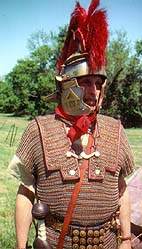


LORICA BODY ARMOR
Updated October 11, 2011
Please consult our Equipment Page for Helmets and other Roman Legionary equipment.




Lorica Segmentata Lorica Hamata (Maille) Lorica Hamata Arm Manica
Armor for Mature Warrior Illustration of Corbridge Hoard
LORICA - SEGMENTATA LAMINATED PLATE BODY ARMORThis classic armor of the Roman Army, came into use during the early First Century AD. Its origin is unknown. To the average person, this style of cuirass denotes the Roman Legionary Soldier. The term applied by the Romans to this armor is now lost to us; however, "Lorica" is Latin for armor and "Segmentata" is a medieval or modern term adopted to describe the system of segments or plates assembled with leather straps and buckles or bronze or iron hooks and eyes along with internal leather straps, hence the current name of Lorica Segmentata. The term "Laminata" is now coming into use in leu of "Segmentata" to describe this type of body armor. The plates were not laminated in the sense that there were two layers of metal laminated together. "Lamina" was the latin term for metal and thus the separate segments were termed as "Lames". The terms "Lamina" and "Lames" were also applied to "scale" or "Squamata" armor as well.
The first types of this armor were termed "Corbridge A or B", based on several partial examples found as a part of the so-called Corbridge Hoard, near Hadrian's Wall in Northumberland, England. The Type "A" was connected together by internal and external leather straps and bronze buckles. The Type "B" still utilized internal leather straps to connect the individual plates, but substituted bronze or iron hooks and eyes, in instead of external straps and buckles, to secure the shoulder units to the torso girdle sections.
Isometric diagram for Corbridge Type A Lorica Segmentata Armor - click to enlarge - At Right, Titus Pontius Maximus (John Collins) is assisted into his Lorica Segmentata by the Commander and Gaius Licinius Marcellus (Daniel Collins). Note the leather subarmalis worn under the lorica to cushion the shoulders and keep perspiration from reaching the lorica to rust it and then bleeding back to stain his tunic.
*** Corbridge B Armor Diagram *** Newstead Armor Diagram ***
*** Corbridge Hoard Diagram and Details ***
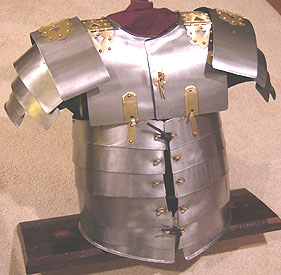
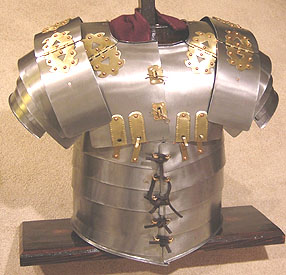
Front and rear views of an updated Newstead lorica based on recent finds and research. See our Newstead Page for more photos and details.
A later version, the so-called "Newstead" Lorica, adopted toward the end of the First Century AD; was a less costly and simpler type of this armor adopted around 100 AD and is based on a partial example found at Newstead Scotland. It was first thought that this style of lorica omitted the hinges and three piece structure on the shoulder units. Recent research indicates that the "Newstead" did have hinges that were larger and wider to make them stronger and less prone to breakage; which was a problem with the smaller hinges found on the "Corbridge" lorica. The "Newstead" was composed of fewer plates overall and was somewhat less comfortable to wear than the more complicated and flexible "Corbridge" style. See the Newstead page for more details.
For what ever reason, segmentata plate armor fell out of favor with the Roman Army by the early Third Century (201-300) AD with a general return to Hamata "ring" maille armor.
HAGAR THE HORRIBLE by Dik Browne
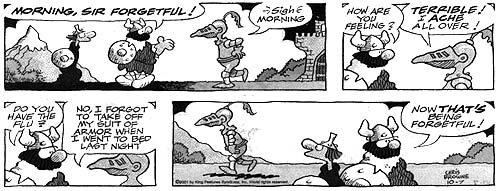
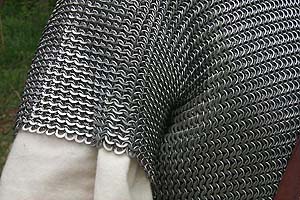
An example of "lorica hamata" or "mail" or to use the french pronunciation, "maille" created by Jeffrey Crean of Souderton PA. It is composed of 12,000 punched "washer-like" rings and a similar number of "butted" wire rings. The Romans are known to have used punched rings to speed the making of mail; as the punched rings did not have to be drawn, coiled, cut apart and riveted, as was required when using wire rings. See photo below. The assembly of mail is not particularly difficult; but is very tedious and time consuming. It took Jeff about 40 hours over four months to assemble this interesting and smart looking variation of hamata body armor. Photo by Richard Campbell.
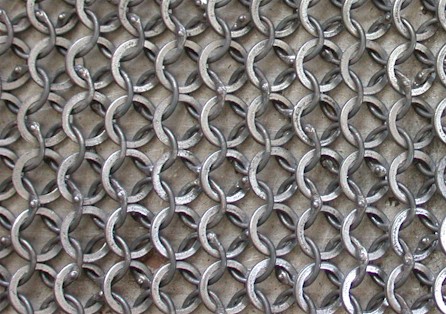
Example of a Roman style of maile / maille assembled from riveted links alternating with punched rings. This is an accurate and authentic Roman style maile, hand made by Erik Schmid http://www.erikdschmid.com mailto:info@erikdschmid.com It is not cheap; but you get what you pay for. If you can afford the best, this is it.
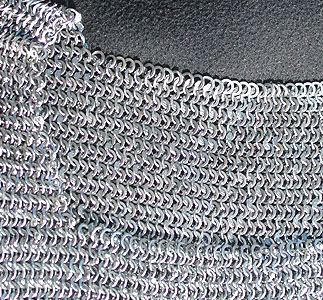
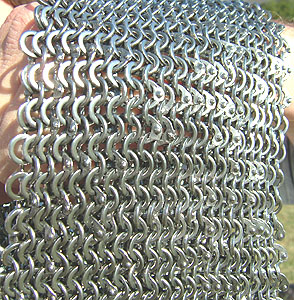
Another example of Lorica Hamata using alternating rows of punched rings and riveted links by Lee Holeva of Legion XXX Ulpia Victrix.


Detail views of the front fastenings on the lorica hamata crafted for the Commander by Jeffery Crean using alternating double rows of some 24,880 butted bronze and steel rings. The body consumed about 21,630 rings, while the doublet collars contain 1080 rings along with another 2170 rings making up the rear portion of the doublet. Jeff spent about 55 hours assembling this attractive variation from the usual all steel-iron ring-mail shirt. The so-called "Hamata Hooks" are used to secure the doublets and keep them closer to the neck for better protection of this vunerable area. The studs are from Albion Armories and the hooks are sand cast brass. The right view illustrates how the studs are secured to the inside front of the lorica with large washers cut from shim brass and backed-up with smaller washers to spread the stress load over many rings and prevent the studs from pulling through the rings. The "doublet" edging is 4 once leather and is hand stitched around the edge of the doublet. Note the interesting pattern of the "Four thru One" linking of the rings.
"Mail", or to use the French pronunciation, "Maille"or "Ring Mail" which is often improperly termed "Chain Mail" or "Hauberk" Armor, is probably the most successful type of body armor ever developed. It is often associated more with the medieval period; but, it was in common use with the Roman Legions long before that time. The term "Mail / Maille" derives from the latin word "Macula" meaning "Mesh of the Net". Mail Armor was invented long before the Roman Period. The place of origin and time of development for mail is not definitely known. The Syrians are thought to have been using it as early as circa 600 BC and it was in use for over a 1600 years, well into the late medieval period. It was most likely introduced to the Roman Army during campaigns against the Celtic Gauls during the Celtic Wars, which ensued after Rome was sacked by the Celtic Gauls, in 390 BC. The Romans are thought to have believed that the Gauls had in fact developed "Mail" for use as body armor. Mail is usually assembled by interlocking one iron or bronze ring with four others, termed a "Four in One" pattern or weave. However, in the middle ages, "Six in One" and even "Eight in One" engagements were utilized for a more protective defense. Such denser patterns were also much heavier and stiffer, with the "Eight in One" being about half-again as heavy as the more traditional "Four in One" pattern. There is no documentation that the Romans ever used the Six in One or Eight in One patterns. The rings were riveted together, requiring skillful labor and patience; thus making its manufacture expensive both in time and material; but it requires a minimum of maintenance being largely self cleaning due to the rubbing action of the rings. "Butted" ring mail, where the ends of the links were not riveted; but simply aligned and butted together came into use in 1700's for parade and display purposes. Such "butted" mail was not suitable or durable for combat use.
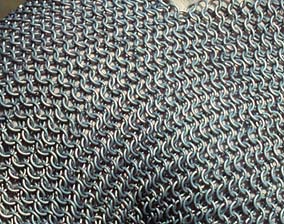
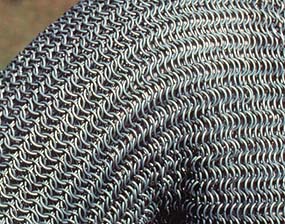
Two views illustrating the difference in appearance of the "Four in One" pattern mail on the left, and "Six in One" pattern mail on the right. Note the greater density of the "Six in One" weave with the rings lying closer and more parallel to one another for better protection against pointed weapons. Although more protective, the Six in One mail also weighs 33 percent more than the Four in One; as it contains a "third" more rings.
The Romans used mail shirts with and without shoulder doublet protection. Mail "Hamata" was generally worn by the Auxiliary troops, in the Empire Period; but legionaries also utilized it. Mail is particularly good as protection against slashing or blunt weapon attacks, but was not as effective as segmentata plate armor as a defense from arrows and stabbing weapons. It requires that a heavy fabric or leather arming gambison garment be worn behind it for maximum protection. It protects in much the same way that modern Kevlar police body armor works, by partially yielding to the blow and then rebounding. It is quite heavy, weighing from 20 pounds up to 40 pounds, but is also more comfortable to wear than plate armor; as it conforms well to the shape of the body. Some of the weight can be transferred from the shoulders to the hips by the use of a waist belt, which was commonly done.
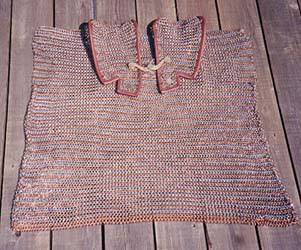
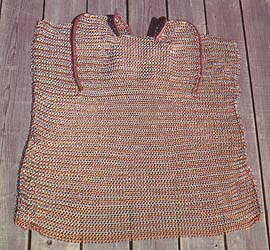
Roman style Lorica Hamata showing the proportions of the shoulder doublet to the overall size of the shirt. The doublet is attached to the back of the shirt by a horizontal row of rings between the ends of the leather edging, shown on the rear view on the right. The doublets provided additional shoulder and upper back protection, as this is where the majority of severe blows would be taken while in battle. Note that the basic mail shirt is contructed as a flat sheet of mail and then joined to form a tube with the upper portion on each side left open to serve as arm holes. Roman mail did not usually have extended sleeves.
Republican Period mail shirts often reached down to mid thigh, while those in the Empire Period were shortened to just below the waist. With the shorter shirt, leather or fabric strips known as "Pteruges" were frequently attached to the undergarment for protection of the upper legs. If the mail garment had no sleeves, pteruges were sometimes worn at the shoulders to ward off blows to that part of the body as well. It is ironic that as Roman Legionaries adopted segmentata plate armor in the first century AD; they may have passed down their more expensive and difficult to make "hamata" mail armor to the supposedly inferior auxiliaries. It is also thought that mail remained in wider use in the warmer climate of the Eastern Empire due to its being somewhat cooler to wear than "laminated" segmentata plate armor. Mail is still in use to today as shark armor and as hand and limb protection in animal slaughter houses
ARM MANICA
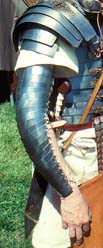
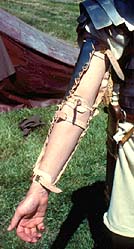

A reconstruction of an arm Manica or "Arm Lorica" by Mathew Amt of Legio XX in College Park, MD. For comfort, it is lined with leather; which is fastened to the plates with leather thongs and secured around the arm with four or five leather straps with buckles.
The Manica or armor for the upper limbs, was not usually issued to, or utilized by Roman Legionary soldiers until later in the Second or Third Centuries AD. The right arm, being exposed and vulnerable, while throwing the pilum or wielding the gladius required special protection, particularly by gladiators in the arena; where its use was most common. There is some evidence for this type of armor also being worn on the legs of mounted calvery soldiers in the later Empire Period.
** SITE INDEX **
* HOME * WEAPONS * EQUIPMENT * LEGIONS OF ROME *